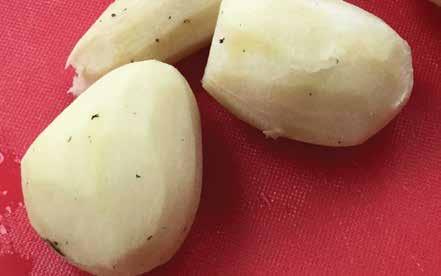
3 minute read
Groundnut
Little-known but old and proud: Try groundnut in your vegetable garden.
Long before Columbus came to this continent, one of our little known native edibles, groundnut (Apios americana) was being consumed and even planted intentionally by indigenous people. It has been gaining popularity again in the last few years for its edible tubers, seeds and as an ornamental plant. Daniel Moerma, in his Native American Food Plants, mentions 14 Native American groups that consumed groundnut. Most of them gathered it from the wild, but there is evidence that a few of them, including the Cheyenne, planted it near their settlements. It is also known as hopniss, wild potato, Indian potato, American potato, American bean, Dakota peas and sea vines.
According the USDA Natural Resources Conservation Service, groundnut is native to most Eastern United States and Canada and is found scattered across Missouri.
There are several reports that groundnut was first introduced in Europe in the 1600s, but soon forgotten and then reintroduced in the 1800s in hopes of replacing the diseased Peruvian potatoes (Solanum tuberosum) known as Irish potatoes. Groundnut has been studied extensively for its potential as a domesticated crop. At Louisiana State University by Dr. W.J. Blackmon, B.D. Reynolds and colleagues studied groundnut for more than 10 years in the 1980s to 1990s and developed better performing varieties. Very few of these varieties are still commercially available; however, more work is needed.
Groundnut is a perennial herbaceous plant that climbs over other vegetation in natural stands forming dense thickets. It can be trained as a vine on an arbor or trellis in gardens. It has pinnately compound leaves with 3 to 7 leaflets and white latex which make the sap appear milky. The edible parts of the plant are the tubers and seeds. The tubers are connected by slender rhizomes, forming a necklacelike appearance. They look like potatoes but their taste is a little sweeter, and in Missouri, one has to wait two years after planting to harvest them. Groundnuts should be cooked before eating, and they can be used in recipes calling for regular potatoes. They can be harvested any time of the year, but are at their best in late fall or early spring before they sprout. The foliage dies off after frost but the tuber never freezes. The seeds taste and look like beans or peas but seed production is not high in Missouri or any other northern states. The attractive salmon-pink color flowers are produced in late summer and early fall which makes it also desirable as an ornamental plant.
It is important to mention that consuming groundnut tubers may cause severe allergies in some people. Interestingly, there have been cases when people became allergic to this food after consuming it several times; there is still no scientific evidence to confirm the cause of this change. So if you want to try it, go slow.
Deer browse on the leaves and preliminary studies conducted in West Virginia suggest that goats may benefit with the consumption of the foliage due to the high protein content; however, they are not recommended for human consumption.
Because of the prolific growth of the vines and the tubers, groundnut should be planted separately in vegetable or native plant gardens because they will be difficult to control. From 2014 to 2017, we grew them in raised beds 6 by 3 ft. adding support for the vines in the community garden at Lincoln University campus. During the first year, tubers grew about an inch in
Photos by Nadia Navarrete-Tindall.


NADIA NAVARRETE-TINDALL Native Plant Specialist
Dr. Nadia Navarrete-Tindall is a Native Plant Specialist and Educator at Lincoln University. She offers educational workshops and other training about native edible plants and other topics on native plants. She can be reached by email at navarrete-tindalln@lincolnu.edu and on her Facebook page “Native Plants and More.”










